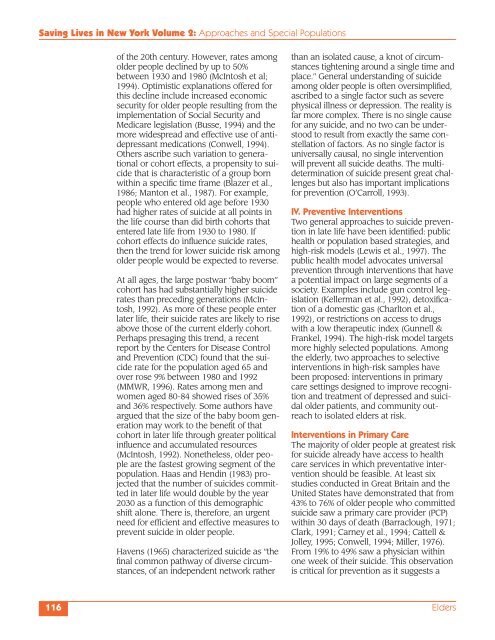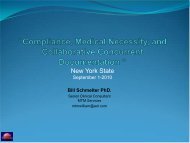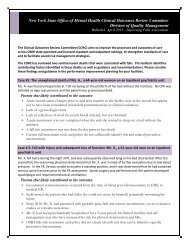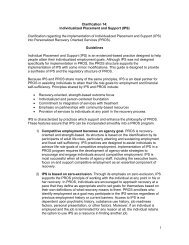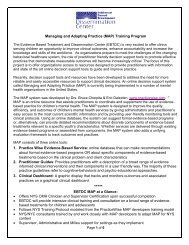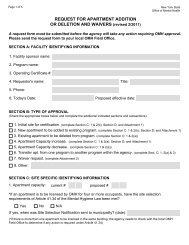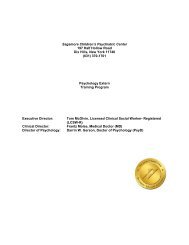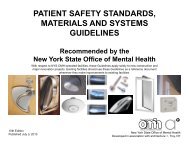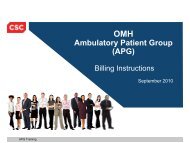Download - New York State Office of Mental Health
Download - New York State Office of Mental Health
Download - New York State Office of Mental Health
You also want an ePaper? Increase the reach of your titles
YUMPU automatically turns print PDFs into web optimized ePapers that Google loves.
Saving Lives in <strong>New</strong> <strong>York</strong> Volume 2: Approaches and Special Populations<br />
<strong>of</strong> the 20th century. However, rates among<br />
older people declined by up to 50%<br />
between 1930 and 1980 (McIntosh et al;<br />
1994). Optimistic explanations <strong>of</strong>fered for<br />
this decline include increased economic<br />
security for older people resulting from the<br />
implementation <strong>of</strong> Social Security and<br />
Medicare legislation (Busse, 1994) and the<br />
more widespread and effective use <strong>of</strong> antidepressant<br />
medications (Conwell, 1994).<br />
Others ascribe such variation to generational<br />
or cohort effects, a propensity to suicide<br />
that is characteristic <strong>of</strong> a group born<br />
within a specific time frame (Blazer et al.,<br />
1986; Manton et al., 1987). For example,<br />
people who entered old age before 1930<br />
had higher rates <strong>of</strong> suicide at all points in<br />
the life course than did birth cohorts that<br />
entered late life from 1930 to 1980. If<br />
cohort effects do influence suicide rates,<br />
then the trend for lower suicide risk among<br />
older people would be expected to reverse.<br />
At all ages, the large postwar “baby boom”<br />
cohort has had substantially higher suicide<br />
rates than preceding generations (McIntosh,<br />
1992). As more <strong>of</strong> these people enter<br />
later life, their suicide rates are likely to rise<br />
above those <strong>of</strong> the current elderly cohort.<br />
Perhaps presaging this trend, a recent<br />
report by the Centers for Disease Control<br />
and Prevention (CDC) found that the suicide<br />
rate for the population aged 65 and<br />
over rose 9% between 1980 and 1992<br />
(MMWR, 1996). Rates among men and<br />
women aged 80-84 showed rises <strong>of</strong> 35%<br />
and 36% respectively. Some authors have<br />
argued that the size <strong>of</strong> the baby boom generation<br />
may work to the benefit <strong>of</strong> that<br />
cohort in later life through greater political<br />
influence and accumulated resources<br />
(McIntosh, 1992). Nonetheless, older people<br />
are the fastest growing segment <strong>of</strong> the<br />
population. Haas and Hendin (1983) projected<br />
that the number <strong>of</strong> suicides committed<br />
in later life would double by the year<br />
2030 as a function <strong>of</strong> this demographic<br />
shift alone. There is, therefore, an urgent<br />
need for efficient and effective measures to<br />
prevent suicide in older people.<br />
Havens (1965) characterized suicide as “the<br />
final common pathway <strong>of</strong> diverse circumstances,<br />
<strong>of</strong> an independent network rather<br />
than an isolated cause, a knot <strong>of</strong> circumstances<br />
tightening around a single time and<br />
place.” General understanding <strong>of</strong> suicide<br />
among older people is <strong>of</strong>ten oversimplified,<br />
ascribed to a single factor such as severe<br />
physical illness or depression. The reality is<br />
far more complex. There is no single cause<br />
for any suicide, and no two can be understood<br />
to result from exactly the same constellation<br />
<strong>of</strong> factors. As no single factor is<br />
universally causal, no single intervention<br />
will prevent all suicide deaths. The multidetermination<br />
<strong>of</strong> suicide present great challenges<br />
but also has important implications<br />
for prevention (O’Carroll, 1993).<br />
IV. Preventive Interventions<br />
Two general approaches to suicide prevention<br />
in late life have been identified: public<br />
health or population based strategies, and<br />
high-risk models (Lewis et al., 1997). The<br />
public health model advocates universal<br />
prevention through interventions that have<br />
a potential impact on large segments <strong>of</strong> a<br />
society. Examples include gun control legislation<br />
(Kellerman et al., 1992), detoxification<br />
<strong>of</strong> a domestic gas (Charlton et al.,<br />
1992), or restrictions on access to drugs<br />
with a low therapeutic index (Gunnell &<br />
Frankel, 1994). The high-risk model targets<br />
more highly selected populations. Among<br />
the elderly, two approaches to selective<br />
interventions in high-risk samples have<br />
been proposed: interventions in primary<br />
care settings designed to improve recognition<br />
and treatment <strong>of</strong> depressed and suicidal<br />
older patients, and community outreach<br />
to isolated elders at risk.<br />
Interventions in Primary Care<br />
The majority <strong>of</strong> older people at greatest risk<br />
for suicide already have access to health<br />
care services in which preventative intervention<br />
should be feasible. At least six<br />
studies conducted in Great Britain and the<br />
United <strong>State</strong>s have demonstrated that from<br />
43% to 76% <strong>of</strong> older people who committed<br />
suicide saw a primary care provider (PCP)<br />
within 30 days <strong>of</strong> death (Barraclough, 1971;<br />
Clark, 1991; Carney et al., 1994; Cattell &<br />
Jolley, 1995; Conwell, 1994; Miller, 1976).<br />
From 19% to 49% saw a physician within<br />
one week <strong>of</strong> their suicide. This observation<br />
is critical for prevention as it suggests a<br />
116 Elders


